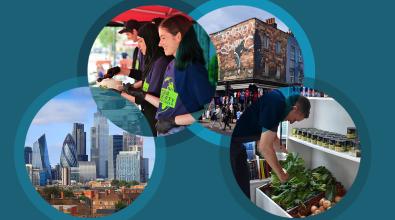How city leaders can stay on message when everything keeps changing

At the end of May, when the number of COVID-19 cases in the U.S. was trending gradually downward, Harvard University Professor Juliette Kayyem told city leaders it was time to slow down their daily tempo of public communications around the pandemic, or what she calls a “battle rhythm.”
A lot has changed in two months. The pace of infections shot up across much of the U.S., protests against racial injustice swept the country, and many cities now are grappling with surges in violent crime. Speaking again to mayors and their senior deputies last week, Kayyem said there’s no denying the reality many city leaders are faced with. “In many parts of the country, we are still living this nightmare,” Kayyem said. “And we will continue to do so.”
The core tenets of crisis communication haven’t changed, Kayyem said in the latest virtual convening of the Leading Social and Economic Recovery Series. Mayors still need to do three things in their public statements. They must convey the facts of the situation, no matter how bad they may be; show empathy for the hardships residents are experiencing; and establish a basis for hope that is grounded in reality.
But the continuing spiral of new and evolving challenges means mayors may need to recalibrate parts of their approach, Kayyem said. Those difficulties are deep: An inadequate national response to the pandemic is eroding the public’s trust; misinformation is rampant; a numbing crisis fatigue is settling in; and it’s getting harder to stay hopeful when the numbers are so obviously going the wrong way.
[Get the City Hall COVID-19 Update. Subscribe here.]
One adjustment Kayyem suggested was for mayors to reestablish that daily battle rhythm of public briefings, if they haven’t already. They also need to make sure staff are providing the right “situational awareness” for the moment.
“The information you need now is probably different than you needed earlier,” Kayyem said. “When everything was closed, you didn’t need information on what was open. Now that some things are open and others are closed, you want to get a sense of what industries are impacted. Big retail chains may be making decisions regardless of what you or the governor want. Your situational awareness is all you have, because you’re going to be communicating what you get. So recheck that.”
For mayors to stay on message in a moment when everything is changing, Kayyem said mayors need to embrace five things:
Embrace data. It’s critical for mayors to stick to facts and tailor the data to their audience. This is especially true in a news environment that thrives on political conflict and a president who stokes it. Kayyem suggested not using his name. When talking to the media, “I will never say the name Donald Trump,” Kayyem said. “I say ‘The White House.’ Depersonalize it.”
Embrace empathy. At a time when people are suffering great personal, economic, and social losses, it’s important for mayors to continue showing empathy for the pain and hardships residents are going through. “People want to hear that you get what they’re thinking and feeling,” Kayyem said.
[Read: How to master crisis communication]
Embrace reality. Kayyem said mayors need to fight harder against the ongoing flow of misinformation spreading on social media and other channels. Today, it’s debunking myths about facemasks causing oxygen deprivation. Tomorrow, it’ll be shooting down misleading claims about vaccination. “We need more pushing back by political leadership on this madness,” Kayyem said. She also warned mayors and their social media teams to be very careful about what information they share so as to not fuel misinformation unwittingly.
Embrace the public. Most people really do understand the severity of the pandemic and want to help, Kayyem said. That may not always come across in news coverage, or in the trolling mayors experience on social media. But if you look at one seemingly contentious issue — facemask policies — not only are an overwhelming majority of Americans in support, but they’re for the most part already living under orders to wear masks in public. “There’s no debate,” Kayyem said. “The public is grasping this. And so you can communicate these things.”
Embrace the future: Mayors need to foster hope by sharing their vision for a better future and the steps they are taking to get there. It’s not about keeping fingers crossed for a vaccine, Kayyem said. Rather, it’s about reinforcing the possibility that, long before there’s a vaccine, we still have a shot at restoring a sense of normalcy if we put in the same hard work that many Asian and European countries have. “Here’s the hope: This is just a stupid virus,” Kayyem said. “We don’t have to play stupid. We can play smart. And we can figure this out.”

